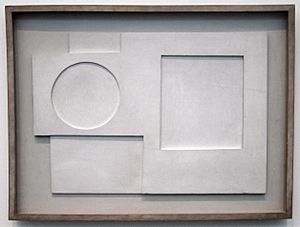Ben Nicholson facts for kids
Quick facts for kids
Ben Nicholson
|
|
|---|---|

Portrait of Ben Nicholson by Mabel Pryde, circa 1910–1914
|
|
| Born |
Benjamin Lauder Nicholson
10 April 1894 Eight Bells, Denham, Buckinghamshire, England
|
| Died | 6 February 1982 (aged 87) Hampstead, London, England
|
| Education | The Slade |
| Known for | Painting |
| Spouse(s) |
Winifred Roberts
(m. 1920; div. 1938)Felicitas Vogler
(m. 1957; div. 1977) |
| Awards | OM |

Benjamin Lauder Nicholson (born April 10, 1894 – died February 6, 1982) was a famous English artist. He painted many different kinds of art. He is well-known for his abstract paintings, which sometimes looked like sculptures with parts sticking out. He also painted beautiful landscapes and still-life pictures. He received the Order of Merit (OM), a special award for his achievements.
Contents
Early Life and Art Training
Ben Nicholson was born on April 10, 1894, in Denham, Buckinghamshire, England. His parents, Sir William Nicholson and Mabel Pryde, were both painters. This meant art was a big part of his family life. He had a sister, Nancy Nicholson, and two brothers, Christopher and Anthony. His family moved to London in 1896.
Ben went to different schools, including Gresham's School in Norfolk. He later studied art at the Slade School of Fine Art in London from 1910 to 1911. At Slade, he was in the same class as other artists who became famous, like Paul Nash and Stanley Spencer. Paul Nash once said that Ben spent more time playing billiards than painting at art school. Ben later explained that the shapes and movements of the billiard balls helped him think about art in an abstract way.
Ben Nicholson was married three times and had six children. His first wife was the painter Winifred Nicholson. They had three children: Jake, Kate, and Andrew. His daughter, Kate Nicholson, also became a painter. His second wife was the sculptor Barbara Hepworth. They had triplets: Sarah, Rachel, and Simon. His third wife was the photographer Felicitas Vogler.
Key Moments in Ben Nicholson's Life and Art
First Works and Early Travels
When Ben was young, around 1904, he met the famous writer J. M. Barrie, who wrote Peter Pan. Barrie used one of Ben's drawings for a poster for the play. Ben's father, William, also helped design parts of the play.
During World War I, Ben did not serve in the military because he had asthma. In 1917, he traveled to New York for an operation. He also visited other cities in America before returning to Britain in 1918. Sadly, his mother died while he was away, and his brother Anthony was killed in the war.
Developing His Unique Style
From 1920 to 1933, Ben lived in London with his first wife, Winifred. After his first art show in London in 1922, his art started to change. He was influenced by Cubism, an art style that uses geometric shapes. He was also inspired by the simple, natural style of Henri Rousseau. In 1926, he became the leader of an art group called the Seven and Five Society.
In London, Ben met important sculptors like Barbara Hepworth and Henry Moore. He also traveled to Paris, where he met Piet Mondrian and Pablo Picasso. Mondrian's abstract style, called neoplasticism, and Picasso's cubism greatly influenced Ben's work. However, Ben was very good at taking these European ideas and making them into his own unique style.
Moving to St Ives and Abstract Art
In 1928, Ben visited St Ives, Cornwall, a beautiful coastal town, with his friend and fellow painter Christopher Wood. There, he met a local fisherman and painter named Alfred Wallis.
In 1933, while in Paris, Ben created his first wood relief artwork. This piece, called White Relief, used only straight lines and circles. It was a very important step in his move towards abstract art. In 1937, he helped edit a book called Circle, which was very important for the art movement called constructivism. Ben believed that everyone should be able to enjoy abstract art. He showed this by creating a large wall mural for a garden in Guildford, Surrey.
In 1939, Ben moved to St Ives, Cornwall, where he lived for 19 years. In 1943, he joined the St Ives Society of Artists.
Awards and Later Life
Ben Nicholson received many important awards for his art. In 1952, he won the famous Carnegie Prize. In 1955, a special exhibition of his work was shown at the Tate Gallery in London. He also won the first Guggenheim International painting prize in 1956 and an international painting prize in Brazil in 1957.
In 1957, Ben married Felicitas Vogler and moved to Switzerland. In 1968, he received the British Order of Merit (OM), a very high honor. He later returned to England, living in Cambridge and then in Hampstead, London.
Ben Nicholson passed away on February 6, 1982, in Hampstead. His ashes were buried at Golders Green Crematorium.
You can see some of Ben Nicholson's artworks in many places, including the Tate Gallery, Tate St Ives, Kettle's Yard Art Gallery in Cambridge, The Hepworth Wakefield, Pallant House Gallery in Chichester, and the Pier Arts Centre in Stromness, Orkney.
Images for kids
-
English Heritage blue plaque at 2B Pilgrims Lane, Hampstead
See also
 In Spanish: Ben Nicholson para niños
In Spanish: Ben Nicholson para niños


